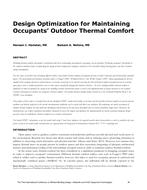
Design Optimization for Maintaining Occupants¿ Outdoor Thermal Comfort
- Comments Off on Design Optimization for Maintaining Occupants¿ Outdoor Thermal Comfort
- ASHRAE
Click here to purchase Citation: 3rd Intl Conf: Efficient Bldg Design
Modeling thermal comfort and people’s satisfaction with their surrounding environment is grasping a lot of attention. Predicting occupants’ tolerability to the ambient conditions helps in optimizing the design of room temperature leading to reduction in the installed cooling/heating power and thus resultant energy consumption. For this sake, researchers have developed different indices that predict thermal comfort of occupants present in indoor naturally and mechanically ventilated spaces. The most widely used thermal sensation index is Fanger’s PMV (Predicted Mean Vote). While Fanger’s PMV allows quantifying the level of comfort of the occupant present in enclosed spaces, it remains inaccurate to be used for assessing the level of thermal comfort of people present in external open spaces such as outdoor pedestrian areas or other spaces specifically designed for outdoor activities. As such, studying outdoor thermal comfort is important in order to optimize the design of the building external construction details as well as the implementation of design measures to the occupied external environment to enhance the occupants thermal comfort. An outdoor thermal comfort model, referred to as the Standard Predicted Mean Vote (SPMV) was developed. The purpose of this study is to benefit from the pre-developed SPMV model and develop an in-house tool that predicts thermal comfort of a person present outdoors and directly subjected to the outside environmental conditions such as wind and direct sun radiation. By conducting an hourly assessment of outdoor thermal comfort, the tool allows for identifying critical hours of the day when discomfort due to external conditions might occur. Moreover, the work presents case studies considered and further simulated to assess the impact and optimize the implementation of various potential adequate design measures onto the individuals thermal comfort in an external environment.For hourly SPMV calculations as per the model built using Visual basic software, the required weather data characteristics as well as available sky view factors based on the model under consideration are acquired from the Integrated Environmental Solution IES
Product Details
- Published:
- 2018
- Number of Pages:
- 7
- Units of Measure:
- Dual
- File Size:
- 1 file , 940 KB
- Product Code(s):
- D-ICEB18-C005

